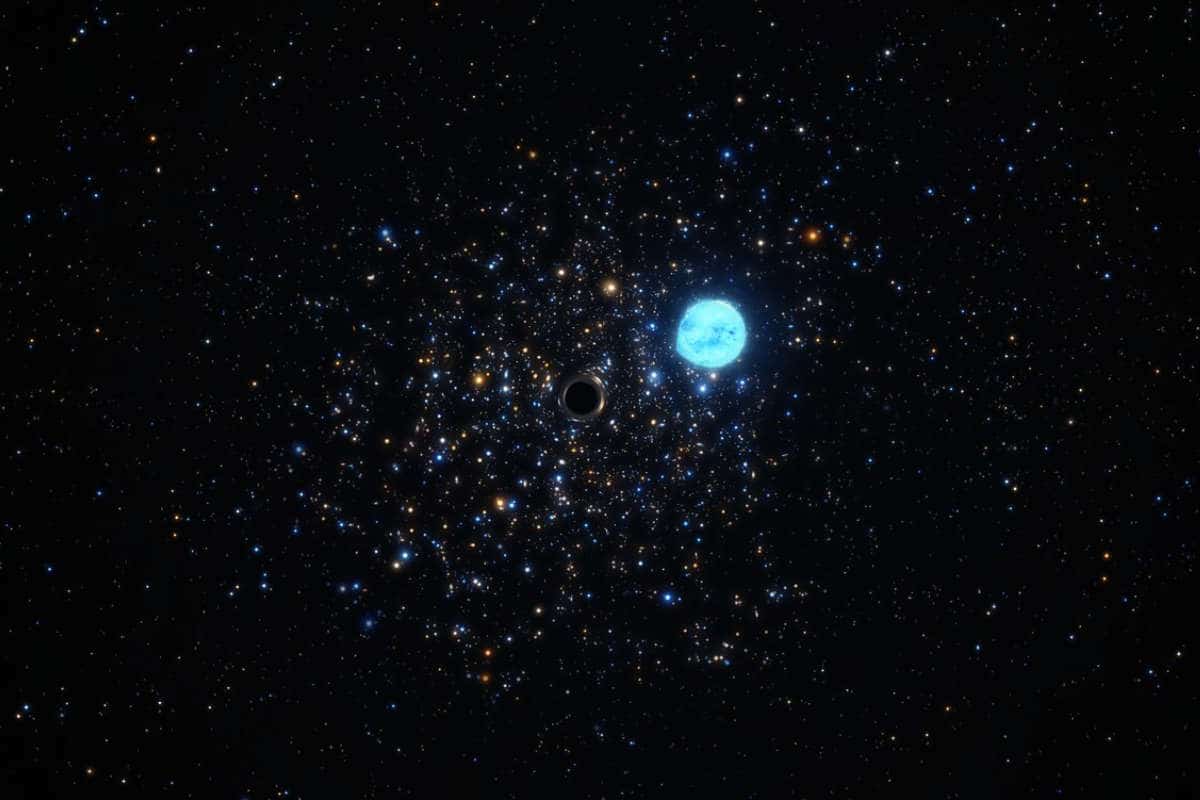
Astronomers may be able to detect more hidden black holes in the same way, which could shed light on how these enigmatic objects form and evolve.
We now know that there are countless black holes in the universe. Finding them, however, is another matter. That’s because you can’t see black holes. They are bizarre objects from which nothing – not particles and not even light – can escape. Still, researchers have now used a highly effective method to detect a black hole hiding in a star cluster outside our Milky Way galaxy. This is thanks to the movement of a nearby star.
NGC 1850
The researchers tracked down the black hole using the Very Large Telescope. The object was hiding in NGC 1850, a collection of thousands of stars about 160,000 light-years away in the Large Magellanic Cloud, a small galaxy neighboring the Milky Way. NGC 1850 is only about 100 million years old – the twinkling of an eye by astronomical standards. The fact that a black hole has been found in this star cluster is therefore quite special. Because it is the first time that a black hole has been discovered in such a young star cluster.

This image shows NGC1850, a collection of thousands of stars in the Large Magellanic Cloud, a small neighboring galaxy to the Milky Way about 160,000 light-years away. The red filaments surrounding the cluster, made up of huge clouds of hydrogen gas, are believed to be remnants of supernova explosions. Image: ESO, NASA/ESA/M. romaniello
How did the researchers come across the black hole? The researchers saw a striking star, whose peculiar movement betrayed the presence of the black hole. The black hole exerts a gravitational influence on a star of five solar masses that orbits it.
Sherlock Holmes
“Much like Sherlock Holmes is tracking down a criminal gang by their missteps, we looked at each star in the cluster through a magnifying glass,” said study lead author Sara Saracino. “We then tried to find clues to the presence of black holes without seeing them directly.” It means that a nearby star made the virtually invisible black hole in the very young star cluster ‘visible’, as it were. It is the first time that this detection method has been used to discover a black hole outside our Milky Way Galaxy.
small black hole
In the meantime, we also know a bit more about this newly discovered black hole. For example, it has about eleven times the mass of our sun, making it a small black hole. Incidentally, it is not the first time that such ‘small’ black holes have been encountered. Previously, specimens have been discovered in other galaxies by detecting the X-rays emitted by black holes when they gobble up matter. They can also be revealed through the gravitational waves emitted by black holes when they collide with each other or with neutron stars. But that is quite rare. Most black holes of some star masses do not betray their existence by emitting X-rays or gravitational waves. “The vast majority can only be discovered through dynamics,” explains researcher Stefan Dreitzler. “When they have an ordinary star as a companion, they influence its movement in a subtle but detectable way, so that we can track them with advanced instruments.”
New detection method
The researchers hope to use their new detection method to reveal several hidden black holes in the Milky Way and in nearby galaxies. “The result shown here concerns only one of the wanted criminals,” Saracino said. “But if you’ve found one, you’re on the right track to discover many more, hiding in other star clusters.”
learn more
And the more black holes we find, the more we can learn about how these enigmatic objects form and evolve. In that case, more young black holes can be compared with larger, more mature black holes in older star clusters. In this way, more insight can be gained into how these objects ‘grow’ by feeding on stars or merging with other black holes. In addition, mapping the demographics of black holes in star clusters would improve our understanding of the origin of gravitational wave sources. “Any detection we make will be important to our understanding of star clusters and their black holes,” said study researcher Mark Gieles.
With the arrival of the under-construction Extremely Large Telescope, which will become operational later this decade, astronomers will be able to detect even more hidden black holes. “The ELT will revolutionize this area,” Saracino says. “This will allow us to observe significantly fainter stars in the same field of view, as well as search for black holes in globular clusters at much greater distances.” And who knows what scientists will unravel about these bizarre objects.
Source material:
“Black hole hides in star cluster outside our Milky Way galaxy” – ESO
Image at the top of this article: ESO/M. kornmesser